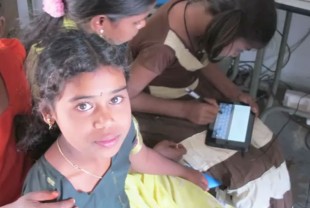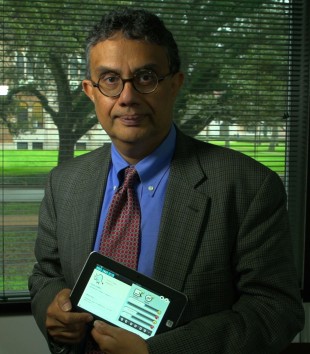MEDIA CONTACTS:
| Rice University David Ruth O 713-348-6327 M 612-702-9473 druth@rice.edu |
Rice University Jade Boyd O 713-348-6778 M 713-302-2447 jadeboyd@rice.edu |
Nanyang Tech. University Wang Meng Meng O (65) 6790 6681 M (65) 9007 9585 WangMM@ntu.edu.sg |
ViDAL Rajeswari Pingali M (91) 986-657-7004 raj@vidal.org.in |
Indian district plans to adopt 50,000 I-slate tablets
US, Singapore developers optimize tech-brain interface in low-cost educational device
HOUSTON — (March 19, 2012) — The U.S.- and Singapore-based creators of the I-slate educational tablet and local government officials in India’s Mahabubnagar District plan to adopt 50,000 of the low-cost electronic educational slates into middle and high school classrooms throughout the district over the next three years. The plans were announced today in Hyderabad, India, by district officials, the Indian non-profit Villages for Development and Learning Foundation (ViDAL), Rice University and Nanyang Technological University (NTU) in Singapore.
The I-slate, a low-cost learning tool designed for classrooms with no electricity and too few teachers, is under joint development by the I-slate Consortium, which includes hardware and software experts at Rice and NTU, social outreach partners from ViDAL and a Los Angeles-based design team.
The district of Mahabubnagar in the Indian state Andhra Pradesh has about 500,000 students in government schools. Consortium leaders and Mahabubnagar officials said they hope to supply I-slates to at least 10 percent of the students over the next three years.
“The I-slate project is about empowering local communities with education and knowledge,” said Rajeswari Pingali, ViDAL founding chairwoman. “Based on two years of lab-to-school testing rounds, today we have a fully functional I-slate which will be adapted by the district education department for expanding the footprint of technology and bringing learning opportunities backed by the latest in modern communication technology for the benefit of rural communities.”
About 30 fourth-generation I-slates were delivered this month to a class of 10- to 13-year-olds at the Mohamed Hussainpalli Village School, which is located in Mahabubnagar District, about 70 miles from Hyderabad. The new I-slates are the first to feature a new “sense-optimized” user interface designed to improve educational outcomes in rural India.
“Sense optimization is a systematic way of improving the user experience by taking advantage of our knowledge of how the human brain processes the information so we can invest the minimum amount of resources for the effectiveness level we’re trying to reach,” said I-slate creator Krishna Palem, a professor at both Rice and NTU. “The I-slate is not a tablet computer. It is a device designed for a single purpose — education in a low-resource environment.”
Mahabubnagar is primarily rural and has a population of around 4 million. District officials plan to use the I-slate in middle and high school classrooms. With sufficient volume, the unit cost for the I-slate will be around $45 (56 Singapore dollars), Palem said.
Palem, Rice’s Ken and Audrey Kennedy Professor of Computing, initially conceived the I-slate in 2008. He thought power consumption would be the biggest hurdle, because many rural schools in India lack electricity, and a solar-powered I-slate would need to run on no more than three watts of power. However, as soon as students in Mohamed Hussainpalli Village began testing early prototypes, it became obvious that usability and effectiveness would also be a challenge.
The I-slate’s Los Angeles-based design team, which includes Marc Mertens, CEO of the Seso Media Group, and project leader Henrik Andersson, volunteered their time to work with ViDAL, NTU specialists in human-computer interaction and Rice student interns Lauren Pemberton, Shelby Reinhardt and Samuel Tang, all seniors, and Carter Wang, who graduated in 2011. The designers evaluated feedback from children at Mohamed Hussainpalli Village School and spent thousands of hours scrutinizing the placement and flow of features and the way children interacted with the I-slate both visually and by touch.
The designers incorporated elements from video games and social networking to draw students in and hold their interest. For example, a colorful cartoon creature in the corner of the I-slate screen watches the student and changes expression based upon the child’s actions. The more the student studies and the better her grades, the happier the creature appears.
The I-slate is a joint project of the Rice-NTU Institute for Sustainable and Applied Infodynamics (ISAID). Palem, who directs ISAID, is a Nanyang Visiting Professor at NTU.
“It is very exciting to see the early work on the I-slate expand to a larger user base,” said ISAID affiliate Vincent Mooney, associate professor of electrical and computer engineering at Georgia Tech, who worked on the I-slate as a visiting faculty member at NTU.
The hardware and graphic content for the I-slate are being developed in tandem because they will ultimately use a revolutionary low-power computer chip — another of Palem’s inventions. The new chip, which could be ready for use in the I-slate by 2013, will cut power requirements in half and allow the device to run on solar power from small panels similar to those used on handheld calculators.
-30-
A high-resolution image is available for download at:
https://news2.rice.edu/files/2011/10/Krishna_Palem.jpg
CAPTION: I-slate creator Krishna Pale
CREDIT: Jeff Fitlow/Rice University
About Rice University
Located on a 300-acre forested campus in Houston, Rice University is consistently ranked among the nation’s top 20 universities by U.S. News & World Report. Rice has highly respected schools of Architecture, Business, Continuing Studies, Engineering, Humanities, Music, Natural Sciences and Social Sciences and is known for its “unconventional wisdom.” With 3,708 undergraduates and 2,374 graduate students, Rice’s undergraduate student-to-faculty ratio is 6-to-1. Its residential college system builds close-knit communities and lifelong friendships, just one reason why Rice has been ranked No. 1 for best quality of life multiple times by the Princeton Review and No. 4 for “best value” among private universities by Kiplinger’s Personal Finance. To read “What they’re saying about Rice,” go to www.rice.edu/nationalmedia/Rice.pdf.
About Nanyang Technological University
A research-intensive public university, Nanyang Technological University (NTU) has 33,500 undergraduate and postgraduate students in the colleges of Engineering, Business, Science, and Humanities, Arts, & Social Sciences. In 2013, NTU will enroll the first batch of students at its new medical school, the Lee Kong Chian School of Medicine, which is set up jointly with Imperial College London.
NTU is also home to four world-class autonomous institutes – the National Institute of Education, S Rajaratnam School of International Studies, Earth Observatory of Singapore, and Singapore Centre on Environmental Life Sciences Engineering – and various leading research centers such as the Nanyang Environment & Water Research Institute (NEWRI) and Energy Research Institute @ NTU (ERI@N).
A fast-growing university with an international outlook, NTU is putting its global stamp on Five Peaks of Excellence: Sustainable Earth, Future Healthcare, New Media, New Silk Road, and Innovation Asia.
Besides the main Yunnan Garden campus, NTU also has a satellite campus in Singapore’s science and tech hub, one-north, and is setting up a campus in Novena, Singapore’s medical district.
For more information, visit www.ntu.edu.sg
About Villages for Development and Learning (ViDAL)
ViDAL is a nonprofit organization based in Hyderabad, India, and works with local communities to empower them through education, knowledge and learning. The flagship I-slate project is the first of its type, bringing the benefits of modern ICT to students living in remote, drought-prone villages.





Leave a Reply